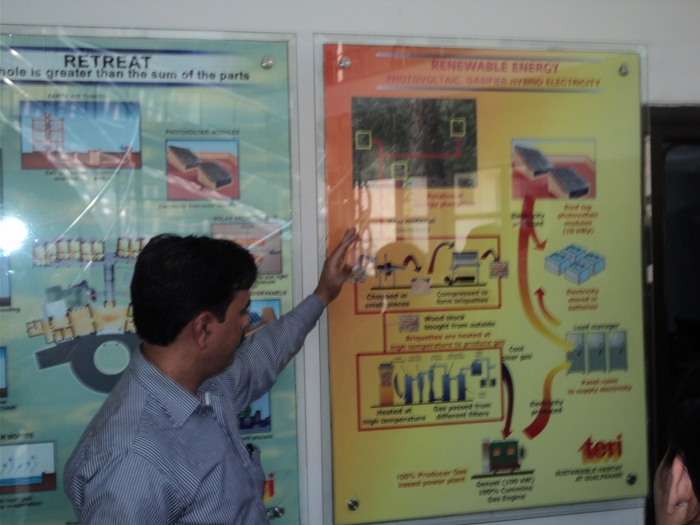TERI- The Energy And Resource Institute: an amazing visit by class 11, Science
TERI, whose director is Mr. Rajendra K. Pachauri, Nobel laureate, was established with the purpose of tackling the immense and acute problems that mankind is likely to face in the years ahead from the steady depletion of the earths finite energy resources. As we know, these are largely non- renewable and the existing methods of their use are polluting.
Consequently, TERI has created an environment that is largely sustainable. The central element in TERIs philosophy has been to create benefits for society through the development of technology to use nature to it's maximum. It's strength lies in identifying the challenges, emabarking upon research and then demonstrating projects. This train leads to the development of specific problem- based and sophisticated technologies that can carry benefits to society at large.
TERI has grown to establish a presence not only in different corners of India which include Bangalore, New Delhi, Guwahati, Mukteshwar and Mumbai but also abroad. At the Himalayan centre in Mukteshwar, a green building makes for an ideal for purposes of repose and research. It has a residential wing, camps, conference hall, tea gardens, rest rooms and internet facility.
We visited the TERI building at Gurgaon. It has a solar passive designed building. It's orientation helps in receiving less radiation resulting in lower heat gains, and reducing the overall air-conditioning requirement. It also saves energy by receiving natural light and ventilation. The structure has a minimal height above the ground, to limit exposure to external conditions. Recessed windows reduce the external solar heat gains. There is a fountain to flow over extensive surfaces to maximize evaporation. Water evaporation has a cooling effect in the surroundings.
[gallery columns="2"]
A building envelope insulates and thereby helps retain cool in summers and the heat in the winter. It is also sound proof. Renewable energy systems in the form of photovoltaic solar panels have been integrated into the roof of the utility building and conference hall to meet a portion of the electrical requirements. An effective solar water heating system is in place to meet the hot water requirements of the buildings inhabitants. Iin the absence of sufficient sunlight, battery- banks provide back up for three days. Fibreglass panels in the ceilings and walls act as insulators, preserving heat and improving acoustics. They have plants with the ability to help recycle water. They have planted deciduous trees for shade during the summer and allow sunlight to penetrate the building during the winter by shedding their leaves. There are also air-humidifiers. A golf course, a cricket ground etc for recreation.
Our exhaustive conducted tour was a huge eye-opener. We were wonderstruck how, so simply yet so effectively, science was incorporated in creating a work space whilst conserving Mother Nature around. It is a lesson for us all as we grow to become engineers, accountants, even householders. The technology we saw, we must make our own.
By Seitu Chauhan, class 11 A.
A Greener Experience at Teri.
On 8 May, 2013, all the students of the Science section went on an educational trip to TERI- The Energy and Resources Institute, located on the Gurgaon- Faridabad Road. All of us were expectedly excited.
We couldn't wait to see Indias first sustainable building-TERI, running entirely on eco- friendly and renewable resources. There were the likes of solar photovoltaic panels and biomass gasifiers waiting to be seen.
TERI is a 100 acres campus which was converted into its present state from a piece of barren land in 1989. The campus consists of modest yet remarkable buildings like the TERI RETREAT, which provides all modern comforts like any other conventional building despite being made of minimal available resource.
The Solar Architecture of the building is indeed very interesting. It is slanting so that the building gets the maximum exposure to sunlight in the winter and minimum exposure to it in the summer.
We were briefed by a short movie on how TERI has helped millions to have a green working environment. We saw different eco-friendly methods and devices in the building that reduced it's power consumption from 280 kW to just 96 kW. The building consists of solar cell panels, solar water heating systems, solar chimneys and solar torches that helps provide electricity at negligible rates after a payment of a heavy initial instalment.
We also came across another interesting concept, namely, EAT ( Earth Air Tunnel System) which helps the building maintain a constant temperature of 25.6 degrees celsius irrespective of the weather outside. We also saw how this tunnel system acworks by transferring the air by underground fans to all the rooms in the building keeping it well ventilated and comfortable. The air conditioners in the conference block use ammonia -free chillers and the rooms in the Retreat building use energy-efficient fluorescent lights.
TERI has also been successful in it's efforts to recycle waste water through the (roots of) Phragmites plant that purifies the 5000 litres of used water per day all round the year.
TERI promotes eco-tourism at Mukteshwar where they have set-up a project called Dera-Green which in turn restores 7 lac tonnes of water every year through its Rain-Water Harvesting system. TERI is very keen to spread awareness about it's unique and sustainable ideas across the world and also teach special farming techniques ( like vermi-culture) and other sustainable practices to common people to make the earth a greener.
Must say what a breath-taking experience it was! We were overwhelmed to explre the creativity of simple science is used to sustain so substantially!
By Shrishti Karana, 11A.













